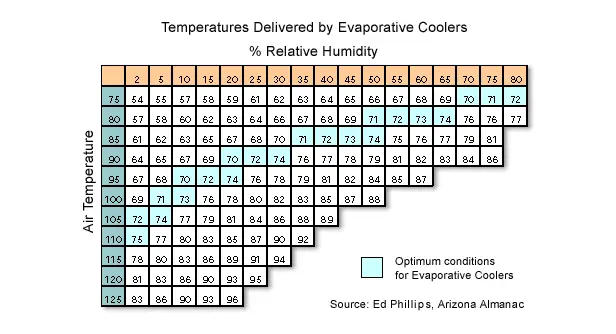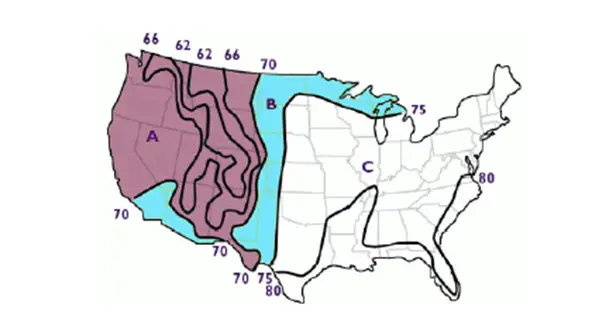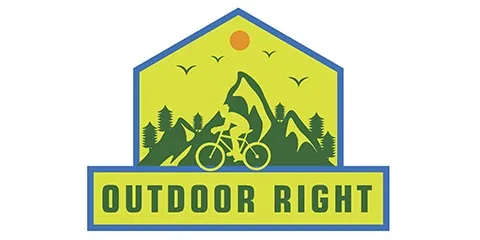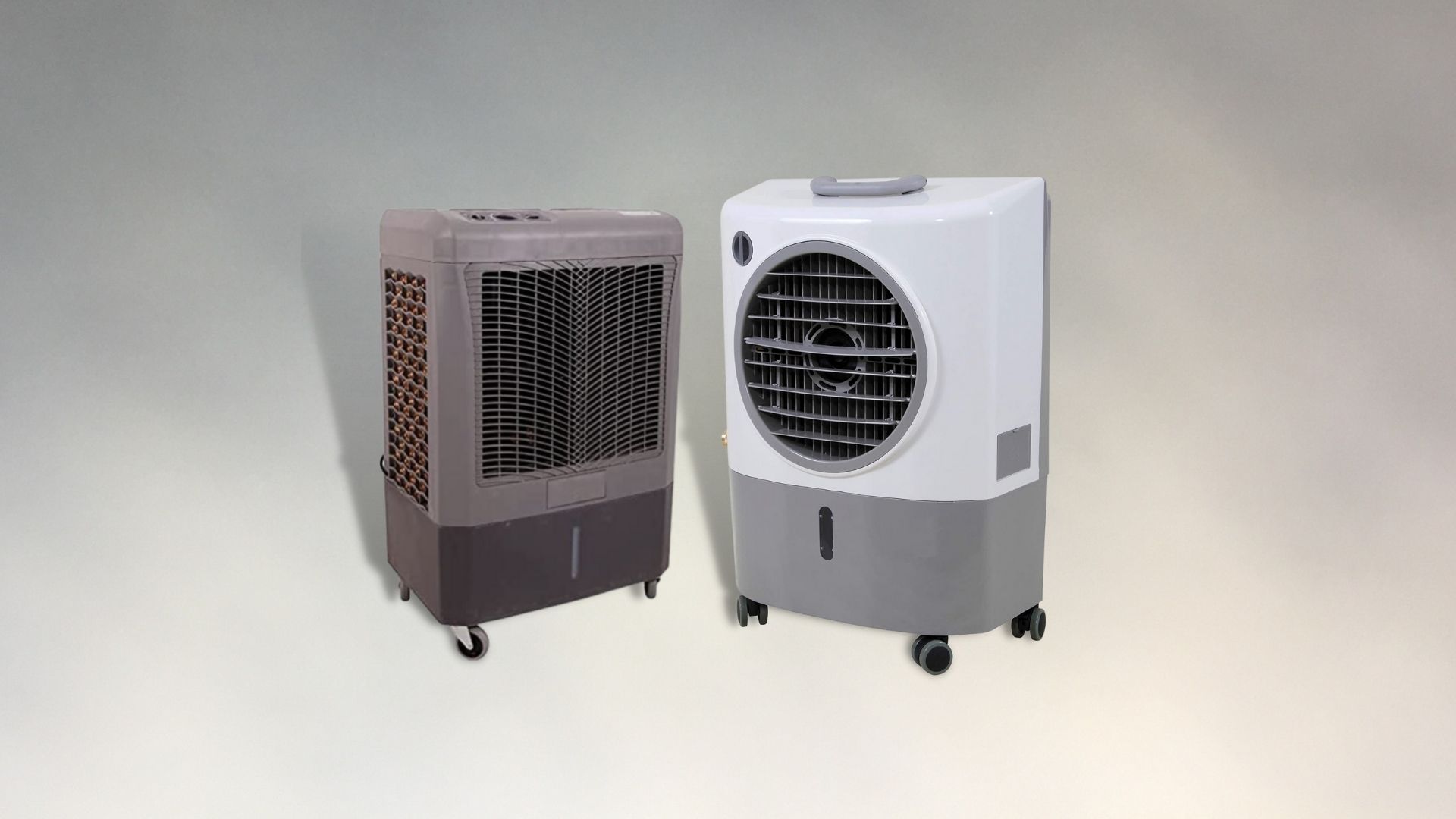Swamp cooler, evaporative air cooler, swamp box, desert cooler, wet air cooler… For a seemingly simple device, the “swamp cooler” has enough names to make your head spin (and possibly warrant a drink from an actual “cooler cooler”).
Built into the roofing of homes in ancient Egypt, swamp coolers have been providing relief from the heat for thousands of years. Like other ancient discoveries and inventions, the simplicity and basic science that led to swamp coolers has stood the test of time.
While modern day swamp coolers almost always incorporate electronic components, the underlying processes that make swamp coolers effective remain unchanged.p coolers effective remain unchanged.
In this article, you’ll learn about the basic science behind swamp coolers, the different types, and a high-level buyers guide to help you decide which portable swamp cooler is right for you.
Table of Contents
Swamp Cooler Science
In the most basic terms, swamp coolers reduce the temperature of the surrounding environment by moving hot dry air over water; usually held within some type of wet cloth or membrane. As the hot dry air moves over the wet membrane or cloth, water evaporates which reduces the temperature of the passing air.
However, to fully understand how swamp coolers work, it’s important to understand the basic natural processes that make this type of cooling technique possible. By understanding the underlying processes, you’ll be able to realize the full potential (and limitations) of swamp coolers.
This will help you make a well-informed decision when it comes time to purchase a swamp cooler for your specific needs.
Phase Transition
The foundational physical process that makes swamp coolers possible is called a phase transition.
It’s late, so I’ll spare you (and myself) a deep dive into thermodynamics. But… In laymen’s terms, a phase transition refers to the movement of physical matter from one physical state (i.e. phase) to another. Some examples include the transition of ice to water (i.e solid to liquid), and water to steam (i.e. liquid to gas).
When physical matter transitions from one phase to another, energy is either absorbed or released. In the case of swamp coolers, the energy being transferred is in the form of heat.
Here’s what the process looks like in swamp coolers:
- Hot dry air travels over a wet membrane in the swamp cooler.
- Energy (heat) from the hot dry air is absorbed by the water in the membrane. (Water can hold a significant amount of heat.)
- Heat is lost as it vaporizes water (on the membrane) into a gas (i.e. humidity).
- This results in lower air temperature, and higher humidity in the surrounding area.
- Humidity is an important factor to consider that we’ll revisit later on.
Humidity vs Temperature
While swamp coolers can be very effective at reducing air temperature in certain conditions, their effectiveness is largely dictated by the relationship between air temperature and relative humidity.
Relative humidity measures the percentage of air that’s saturated with water vaporat a certaintemperature. This is important because hot air can hold more water vapor than cold air- which relative humidity takes into account.
- Relative Humidity at 0% = No Water Vapor in Air
- Relative Humidity at 100% = Air Completely Saturated
- This is also the point at which rain will occur in clouds.
So what does this have to do with evaporative air coolers?
As we know, swamp coolers pull hot ambient air over water, which causes the water to evaporate while reducing air temperature in the process. However, the more saturated the air is with water vapor (high relative humidity) the less effective swamp coolers are at cooling the surrounding air.
Simply put- if the air is completely saturated with water vapor, evaporation can’t take place and the entire process grinds to a halt (including your swamp cooler).
In the chart below, you can see the relationship between temperature, relative humidity and how they contribute to the performance of swamp coolers.

In the most extreme example of good performance (such as a 110 degree air temperature and 2 percent relative humidity) we can see that a swamp cooler can reduce the temperature by as much as 30 degrees. However, if we look at a 75 degree temperature with a relative humidity of 80 percent, we can see that a swamp cooler will only lower the temperature by 3 degrees.
The higher the relative humidity, the less effective swamp coolers will be at cooling the surrounding air.
That brings us to the next section: climate.
Climate
The climate where you’re located will play the biggest role in deciding whether or not to buy a swamp cooler- or if it’s even viable to use one in your area.
As a reminder, climate and weather are two different things:
- Weather is the daily activity and conditions of the atmosphere.
- Climate is the weather of a given location or region averaged over time.
In climates with low humidity, such as the intermountain west and desert southwest, swamp coolers will perform well and are generally worth the investment. However, in humid climates such as appalachia and new england, swamp coolers will perform poorly, and normal air conditioners are the only viable option to cool the air.

Source: USGS/California Energy Commision
Ventilation
Last but definitely not least is ventilation.
It may seem counter-intuitive, but swamp coolers add humidity to the air as a bi-product of evaporation and the cooling effect that they provide. As we’ve discussed, higher humidity will decrease the performance of swamp coolers.
While a little bit of humidity is fine (and often a welcome benefit of swamp coolers), you must create a way for the majority of the humidity to exit the space where the swamp cooler is located. This can be as simple as cracking a window, or opening a door or window at regular intervals.
If left unchecked, humidity levels will increase to the point where the swamp cooler becomes ineffective and makes the air uncomfortable and muggy.
I recently purchased a swamp cooler for my home and was perplexed and disgruntled when the air inside actually began to feel warmer than outside. With the wildfire smoke as thick as it’s been, I wasn’t opening my windows enough.
I quickly realized that the humidity from my swamp cooler was building up, which turned my home into a 95 degree sauna; or dare I say… swamp. Great for cajun theme parties and hot yoga, but just short of torture during the nine to five grind.
Keep this in mind, especially if outside air quality is an issue and you can’t open windows while using a swamp cooler. If that’s the case, cooling with a simple electric fan may be a better option until the air clears up.
Buyers Guide
Types of Portable Swamp Coolers
There are two main types of swamp coolers: direct and indirect.
Direct swamp coolers lower the temperature of the surrounding air through evaporation and increasing humidity in the space where the swamp cooler is located.
*With regards to portable swamp coolers, these are almost always direct.
Indirect swamp coolers also lower the temperature of air through evaporation, however, instead of emitting the cool humid air directly into the space being cooled, the air is used to cool a heat exchanger which cools the inside air. In short- the moist cool air exiting the swamp cooler is never released into the space being cooled. Indirect swamp coolers are almost always used in non-residential spaces (like warehouses) due to their size.
Power Source
There are only a handful of portable swamp coolers that are entirely self contained- meaning, they can power themselves entirely from internal batteries. These are all small devices (like this one) that will only run for a few hours when operated off of internal batteries.
For reliable cooling, you’ll have better results by sticking to a regular plug-in swamp cooler.
If you don’t have access to power at your location, you’ll need to use a battery bank and/or solar power to keep your swamp cooler running. Check out this article for more info about solar power and battery banks.
Use Case
Direct swamp coolers are generally defined by a few main characteristics and specifications:
- Whether they’re designed for indoor use, outdoor use, or both.
- How much square footage that they can effectively cool.
- How much water they can hold.
Outdoor swamp coolers are generally larger, more powerful and more expensive than indoor swamp coolers. These can be a great addition to group outings like camping trips and barbeques, but keep in mind that you’ll need a reliable power source to keep the party going.
Options like the Hessair Evaporative Air Cooler will cover spaces up to 1,600 square feet, and can be attached to a standard garden hose for continuous filling (versus having to manually refill the tank) every few hours).
- Experience Superior Cooling: Embrace the evaporative air cooler capabilities of...
- Transform Your Living Space: Adapt to any environment with portable evaporative...
- Simplify Your Cooling Routine: Say goodbye to complex controls with our...
- Enjoy Continuous, Quiet Cooling: Molded with a lightweight polypropylene resin,...
- Cool Air Anywhere: As a trusted name in air-movement and cooling solutions since...
Indoor swamp coolers are smaller, less expensive, but cover less square footage than larger outdoor swamp coolers. Options like the Evapolor Evalight Plus and the Evapolar evaChill are great for small spaces such as an RV or tent. They can both cool spaces up to 45 square feet, which is about the size of a bed or couch.
- 3-in-1 COOLING – evaLIGHT PLUS cooler humidifies and chills the air using...
- EASY TO SET UP AND USE – simply add water then plug into power supply,...
- PORTABLE - evaLIGHT PLUS personal air conditioner sits conveniently on any desk...
- NANO-THIN FIBROUS STRUCTURE: that creates huge surface for water evaporation and...
- ENLARGED WATER TANK increasing the working time up to 8 hours
- Cooling 3in1: Evapolar evaChill mini AC cools & humidifies the air using...
- Natural Personal Cooling: Efficiently cools your personal space using...
- Energy-Efficient and Cost-Saving: Consumes only 10W and saves your bills. Can be...
- Safe for Breathing: Our material is made from long-lasting basalt fiber, which...
- Portable: EvaChill air cooler are portable and quiet, can also be powered via...
I own a Honeywell Evaporative Air Cooler which can cool spaces up to 300 sf. While it would an awkward fit in a tent, I would definitely use it in my slide in truck camper.
- Energy Efficient Cooling: Honeywell's evaporative air cooler works naturally...
- Digital Controls: You can use the LED control panel on the unit to program your...
- Portable on Wheels: The evaporative cooler is designed with 4 caster wheels and...
- Top Loading Ice Compartment: When dealing with extremely hot temps, inserting...
- Carbon Dust Filter: This filter helps to cleanse the air of large dust...
FAQ
Should I buy a portable swamp cooler?
Swamp coolers can only be used in specific climates and regions. This makes them one of the easier calculated purchases I can think of. Start by asking yourself these questions:
Do I live east of the Rocky Mountains (in the contiguous United States)?
- If your answer no, you’re in luck! A swamp cooler will likely perform well in your region and climate.
- If the answer is yes, do you live between the Rocky Mountains and Lincoln, Nebraska?
- If your answer is no, a swamp cooler will not be practical in your climate.
- If the answer is yes, you’ll need to do some research and figure out what your average relative humidity is during the hottest months of the year.
Swamp coolers are not effective when the relative humidity of the outside air rises above 70-80%, so take this into consideration before purchasing.
Is humid air warmer than dry air?
To answer the question- no. Humid air is not warmer than dry air, though it may feel like it in the presence of high relative humidity.
While it’s true that humid air can feel muggy and warmer than dry air, if you’ve ever lived through a Midwestern winter, you know that humid air can also make it feel much colder outside.
The warmer that air becomes, the more moisture it holds- however, the true ambient air temperature (also known as the “Dry Bulb”) temperature will be the same regardless of how much moisture is in the air.
Conclusion
Since the first recorded use in ancient Egypt, the basic science and processes that make swamp coolers work has remained largely unchanged.
There are many things to consider before purchasing a swamp cooler, and depending on your climate, swamp coolers may not be practical. However, for those who live in dry and arid climates, portable swamp coolers can provide an affordable and effective cooling solution for camping trips, outdoor gatherings, and in-home use.

Alex Mwangi is the creator of Outdoor Right and an outdoor enthusiast. During his free time he enjoys riding his road bike or traveling the world looking for his next adventure.






